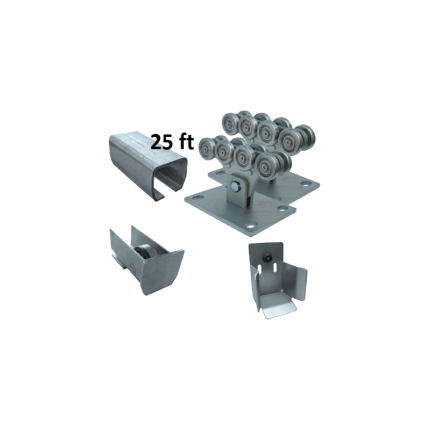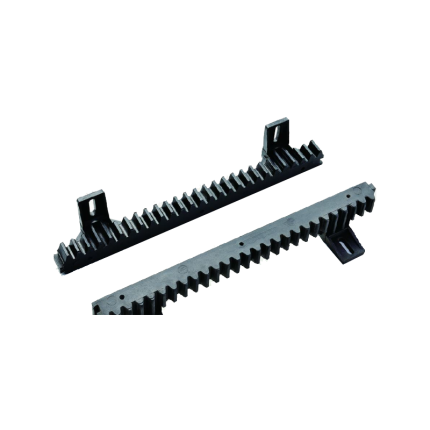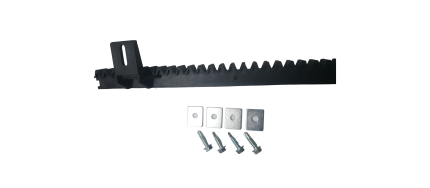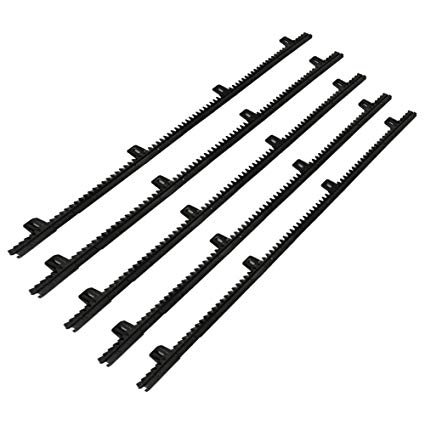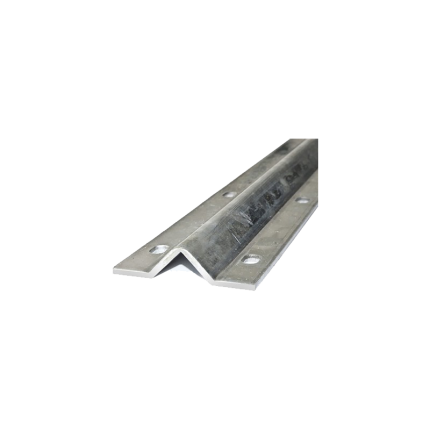track
Cantilever Sliding Gate Hardware
Ship or pick up from our office.
Cantilever Sliding Gate Hardware
Cantilever sliding gate hardware refers to the specialized components that allow a gate to slide open and close without needing a track on the ground. Instead, the gate is supported and guided from above and to the side by a system of rollers and channels. Here's a breakdown of the essential components that make up cantilever sliding gate hardware:- Cantilever Track (or Rail):
- This is the most distinctive part. It's a heavy-duty, usually C-shaped (or sometimes a more complex extruded profile) channel that's securely attached to the bottom (or sometimes top) of the gate frame itself.
- The track is extended beyond the main gate opening to form the "tail" or counterbalance section, which supports the gate when it's fully open.
- Materials: Commonly made from galvanized steel for strength and corrosion resistance, or aluminum for lighter weight and superior corrosion resistance (as discussed previously).
- Cantilever Carriages (or Trolleys/Rollers):
- These are the critical load-bearing components. They consist of a sturdy base plate with multiple wheels (often 5, 8, or more) arranged in a specific configuration.
- The wheels are made from durable materials like steel (often machined or cast) or high-impact nylon, and typically feature sealed bearings for smooth, maintenance-free operation.
- The cantilever track fits over these carriages, with the wheels rolling inside the track's channel.
- Two (or more for very long/heavy gates) carriages are typically mounted on strong concrete foundation posts, positioned outside the gate opening. These posts support the entire weight of the gate.
- Guide Rollers/Plates (Upper Guides):
- These are smaller rollers or plates mounted on a separate guide post (or posts) on the same side as the cantilever carriages.
- Their purpose is to keep the gate upright and prevent it from tipping over as it moves. They typically engage with the top rail of the gate.
- Made from nylon, steel, or a combination, often with adjustable brackets.
- End Cups / Receiver Posts / Gate Catches:
- End Cup (or End Stop): A cup or bracket mounted on the support posts at the fully closed position. The end of the gate's tail section (specifically the track) "rests" in this cup when the gate is fully closed, providing additional stability and support.
- Receiver Post / Gate Catch: A post or latching mechanism at the opposite end of the gate opening. When the gate is fully closed, it engages with this post to secure the gate in the closed position. This is often where a lock or the gate operator's arm connects.
- Support Wheels / Final Wheels: Sometimes, a small support wheel is mounted on the ground or a low post at the far end of the gate opening to provide extra support to the gate's leading edge when it's fully closed, especially for very long or heavy gates.
- Anchoring and Installation Accessories:
- Foundation Plates/Anchor Bolts: Heavy-duty plates and bolts used to securely anchor the cantilever carriages to concrete foundations. The stability of the entire system relies on robust anchoring.
- Tension Bars (less common in modern designs): Historically used for minor adjustments to gate alignment or sag, though modern systems are often designed to minimize this need.
- No Ground Track: This is the primary advantage. Eliminates the need for a track embedded in the driveway, which means:
- No debris accumulation (leaves, dirt, snow, ice) obstructing movement.
- Smoother operation on uneven driveways.
- Less maintenance in terms of track cleaning.
- No tripping hazard or wear on vehicles crossing a ground track.
- Durability and Low Maintenance: Because the main rolling components (carriages) are elevated and enclosed within the track, they are less exposed to dirt and weather, leading to longer life and less frequent maintenance.
- High Security: Cantilever gates are inherently very secure as they are difficult to lift or derail.
- Aesthetics: The absence of a ground track can contribute to a cleaner, more streamlined look for the driveway entrance.
- Suitable for High-Traffic Areas: Their robust design makes them ideal for commercial, industrial, or busy residential applications.
- Gate Automation and Supply Companies: Businesses specializing in automatic gates will carry a full range of cantilever hardware. Examples include Royal Gates (Royal Electronic Technology Center Co.), presence in the Metro Vancouver area, including Surrey.
- Fencing and Gate Fabricators: Many companies that custom-fabricate gates will also supply or install the necessary hardware.
- Industrial Hardware Suppliers: Larger industrial suppliers may stock components, though specialized gate companies will offer more comprehensive systems.
- Online Retailers: Many online suppliers ship to Canada, offering a wide variety of components from different manufacturers.
Sliding gate operator gear rack -SLGR2
Ship or pick up from our office.
Sliding gate operator gear rack -SLGR2
The Sliding Gate Operator Gear Rack SLGR2 is a specific type of toothed bar used in conjunction with a sliding gate operator (motor) to convert its rotational power into the linear motion needed to open and close a sliding gate. Let's break down what SLGR2 likely refers to and its characteristics: Function of a Gear Rack:- Linear Motion: The Sliding Gate Operator Gear Rack SLGR2 is essentially a straight "rack" of teeth that meshes with a small circular gear called a pinion, which is attached to the shaft of the sliding gate operator's motor.
- Power Transmission: As the pinion spins, its teeth engage with the teeth of the gear rack, pushing or pulling the gate horizontally along its track. This is how the motor physically moves the gate.
- Length: The Sliding Gate Operator Gear Rack SLGR2 is specified as being 340 mm (millimetres) in length. This is a relatively short segment. Sliding gates often require multiple sections of gear rack to be joined together to span the entire length of the gate, as most gates are much longer than 340mm.
- Mounting Holes: It has "2 Holes". These holes are pre-drilled for easy attachment to the bottom frame of the sliding gate using screws or bolts.
- Material: While the exact material for this specific SLGR2 is not explicitly stated in all listings, gear racks are commonly made from:
- Steel (most common): Offers high strength, durability, and resistance to wear, making it suitable for heavy gates and high-traffic applications. Often galvanized or treated for corrosion resistance.
- Nylon with a Steel Core: A popular alternative. The nylon exterior provides quieter operation and good corrosion resistance, while the internal steel core offers the necessary strength and stability for the gate's weight and movement. This is a good balance of properties.
- Less commonly, other plastics or stainless steel are used for specific applications.
- "Module": While not explicitly stated for SLGR2, gear racks (and their mating pinions) adhere to a "module" standard (e.g., Module 2, Module 4). The module defines the size of the teeth and the spacing between them, ensuring that the gear rack properly meshes with the pinion gear of the specific sliding gate operator it's intended for. The SLGR2 would have a specific module that matches the operators sold by Royal Gate.
Sliding gate operator gear rack -SLGR41
Ship or pick up from our office.
Sliding gate operator gear rack -SLGR41
*4 Holes *Length: 1018 mmSliding Gate V-Track
Ship or pick up from our office.
Sliding Gate V-Track
NOTE: For 25 ft sliding gate V-Track, please do not make an online order.Because of the limit of the shipping length and weight, we have to cut the full length of the product (25') to 2 x (12'-6") for pick-up from our store OR 4 x (6'-3") to send by Canada Post.
If your order requires cutting services, additional costs will apply.
To create an order for sliding gate V-Track, please send your request with the shipping address, postal code, and the length of your inquiry in the note. You will receive a quotation with the shipping costs within a maximum of one business day. A sliding gate V-track is a specific type of ground track that a sliding gate rolls on, utilizing wheels with a complementary V-shaped groove. This system is one of the most common ways to implement a sliding driveway gate, especially for residential and light commercial applications. Here's a breakdown: Purpose: The sliding gate V-track as the linear guide and support for the entire sliding gate. It ensures that the gate moves in a straight line, smoothly, and without wobbling or derailing as it opens and closes. It's an integral part of a "rolling gate" system, where the gate literally rolls on the ground. Key Characteristics and Components:- V-Shape Profile: The most defining feature. The track has an inverted V-shape or a 90-degree angle (like an angle iron) with a slightly rounded top. This V-shape mates perfectly with the V-groove wheels attached to the bottom of the gate.
- Materials:
- Galvanized Steel (Most Common): Highly durable, strong, and resistant to corrosion due to the galvanization process. It can handle heavy gates and high traffic volumes. Sections are typically joined together to form the required length.
- Aluminum: Lighter weight and excellent corrosion resistance. Often used for lighter gates or in environments where rust is a major concern (like coastal areas).
- Installation:
- Bolt-Down: The V-track is typically designed to be bolted securely to a concrete driveway or foundation. It has pre-drilled holes for anchor bolts. This allows for easier installation on existing concrete and simpler replacement if a section gets damaged.
- Embeddable (Less Common for DIY): Some V-tracks are designed to be embedded directly into wet concrete during construction.
- Level and Straight: Crucially, the V-track must be installed perfectly level and straight along the entire travel path of the gate to ensure smooth and consistent operation. Any dips, humps, or curves will cause issues with the gate's movement and can put undue strain on the gate operator and wheels.
- Lengths: Sliding gate V-tracks are sold in sections (e.g., 6 feet, 10 feet, 2.4 meters, 3 meters). Multiple sections are joined together using connection pins or by welding to achieve the total required length, which should be at least twice the width of the gate opening to allow the gate to fully retract.
- Complementary Hardware:
- V-Groove Wheels: These are essential and roll directly on top of the V-track. As discussed previously, they have a V-shaped groove that fits snugly into the track.
- Guide Rollers/Posts: Used at the top of the gate to keep it upright and prevent tipping.
- Gate Stops: Installed at the ends of the track to prevent the gate from over-traveling.
- Stability: The sliding gate V-track V-groove design provides excellent lateral stability, keeping the gate aligned and preventing it from wobbling.
- Load Capacity: Due to the direct ground support and robust V-track/wheel combination, these systems can handle very heavy and long gates.
- Simple Mechanical Principle: The system is straightforward, making it reliable.
- Debris Accumulation: The main drawback is that the V-track, being on the ground, is susceptible to collecting dirt, leaves, gravel, snow, and ice. This debris can obstruct the gate's movement, cause wear on the wheels, and may even lead to derailment or damage to the gate opener. Regular cleaning of the track is essential, especially during winter months in Canada.
- Driveway Disruption: Installing a sliding gate V-track requires modifying the driveway surface, often by bolting it down or embedding it in concrete, which creates a slight raised profile.
- Water Drainage: Proper drainage around the track is important to prevent water pooling.

